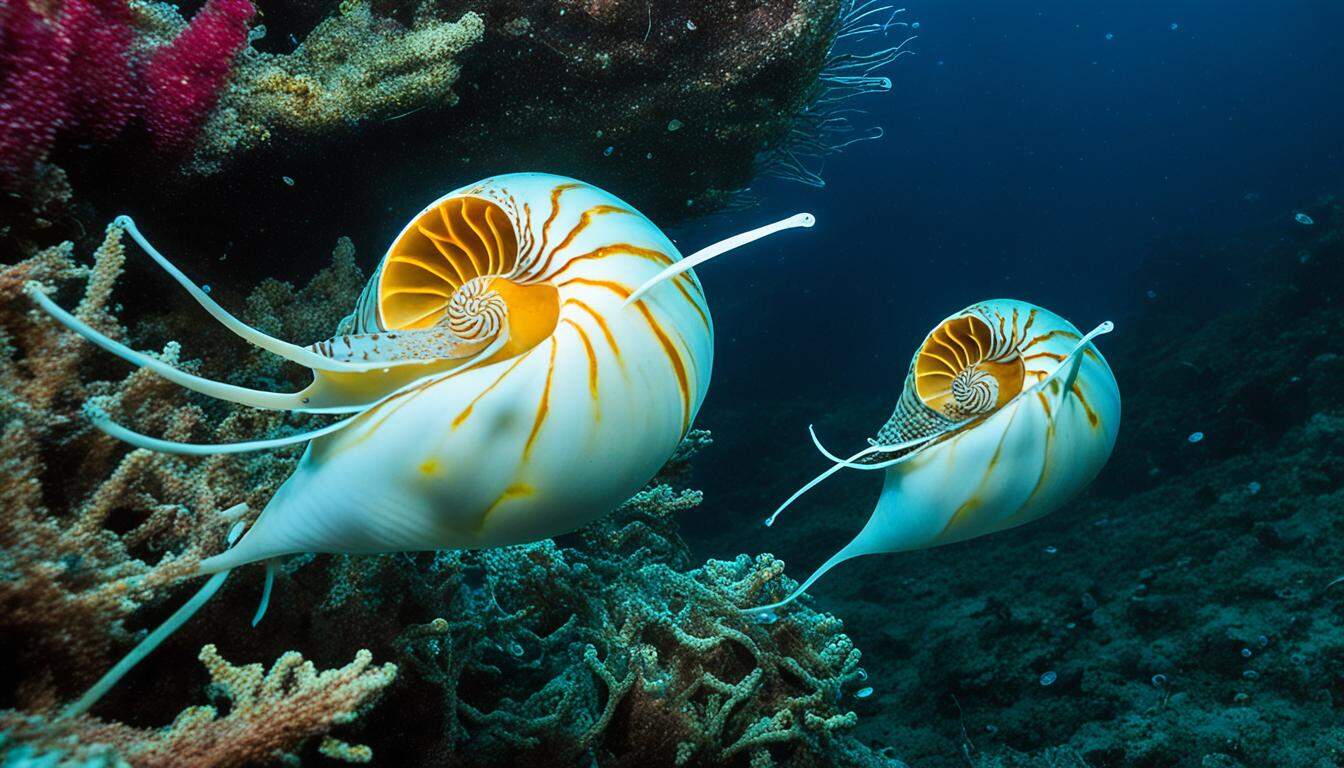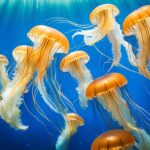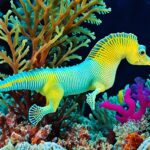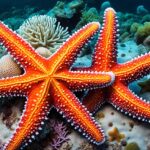The nautilus is often called a living fossil because it has been around for so long. You might be curious about how these creatures find their food. They use a mix of instinct and function to hunt in the deep ocean.
Nautiluses have special tentacles that help them catch prey. They also have ways of hunting that show how they survive. In this article, we’ll look at how nautiluses find and catch their food.
The Fascinating World of Nautiluses
Nautilus species are truly amazing marine creatures. They have caught the attention of scientists and nature lovers. Nautilus pompilius is especially notable for its spiral shell and unique traits. Its story shows us its amazing biology and its important role in the ocean.
Understanding Nautilus Pompilius
Nautilus pompilius has a beautifully coiled shell that protects it and helps it stay buoyant. This shell lets it move through different ocean depths, where it finds a variety of marine life. It can live in both shallow and deep waters, showing how resilient and adaptable it is.
It lives in the warm, tropical waters of the Pacific and Indian Oceans. This adds to the diversity of life in these areas. Seeing these living fossils in the wild gives us a peek into their evolutionary history.
Living Fossils: A Historical Perspective
Nautilus pompilius is called a “living fossil” because it has been around for over 400 million years. It has survived many mass extinctions that killed off many other species. Its unchanged look over all these years shows how well its design works in different environments.
Studying these ancient animals gives us important insights into marine life and how the environment has changed over time.
Nautilus Anatomy and Hunting Tools
The nautilus has a special design for its life deep in the sea. It has a unique tentacle structure and a vital siphon function. These features help it hunt and move through the water with ease.
Unique Tentacle Structure
Nautiluses have about ninety tentacles that are different from other cephalopods. They have grooves on their tentacles that help them grip and hold onto prey. This lets them catch and handle their food better.
They can wrap their tentacles around their prey, making sure it doesn’t get away. This makes hunting more successful for them.
The Role of the Siphon in Movement
The siphon is a key part of the nautilus that helps with movement and staying afloat. It lets the nautilus move quickly when it needs to. This helps it escape from predators and catch its prey.
By controlling the water coming out of the siphon, the nautilus can also change its position in the water. This helps it hunt more effectively.
| Feature | Description | Importance in Hunting |
|---|---|---|
| Tentacle Structure | Approximately 90 tentacles with grooves | Enhances gripping and manipulation of prey |
| Siphon Function | Organ for jet propulsion and buoyancy | Facilitates quick movement and positioning |
How do nautiluses hunt for food?
Nautiluses have complex ways of hunting that show how well they adapt to different places. They use special hunting methods, like active hunting and passive scavenging. These strategies help them find food in their underwater world.
Active Hunting vs. Passive Scavenging
Active hunting means chasing live food, like crustaceans. Nautiluses move around to find food, using their sense of smell to track it. They can’t see well, but their sense of smell helps them find food in many places. Some of their main food targets are:
- Crustaceans
- Small fish
- Worms
Passive scavenging is another way nautiluses get food. They eat dead animals that fall to the ocean floor. This way, they don’t use a lot of energy to find food. It shows how they can survive by taking advantage of what’s available. Here’s a table that shows the differences between active hunting and passive scavenging:
| Aspect | Active Hunting | Passive Scavenging |
|---|---|---|
| Energy Expenditure | Higher | Lower |
| Prey Type | Live organisms (e.g., crustaceans) | Decaying organic matter |
| Detection Method | Chemosensory organs | Olfactory cues |
| Success Rate | Varies with conditions | Consistent due to availability |
Nautiluses use both active hunting and passive scavenging to survive. This shows how well they can adapt to different situations. It makes them interesting creatures to learn about.
Nautilus Feeding Habits
Nautiluses have interesting ways of eating that mainly involve meat. They love to eat crustaceans like shrimp and crabs. Knowing what they eat helps us understand how these ancient sea creatures survive. They change how they eat based on what’s available to them, which is key to their survival.
Dietary Preferences: Shrimp, Crabs, and More
Nautiluses eat a variety of small sea animals because they are opportunistic feeders. This means they eat whatever they can find. They use their tentacles to catch food and bring it to their beak-like jaws to eat. Here are some important facts about their eating habits:
- Variety in Diet: Nautiluses eat different types of crustaceans.
- Efficient Capture: Their tentacles have suckers that help them hold onto slippery food.
- Opportunistic Feeding: They eat whatever they can find, sometimes even scavenging.
Here’s a quick look at what nautiluses like to eat and some examples of their favorite foods:
| Type of Prey | Examples |
|---|---|
| Shrimp | Various species |
| Crabs | Small crabs and young ones |
| Other Marine Animals | Small fish and mollusks |
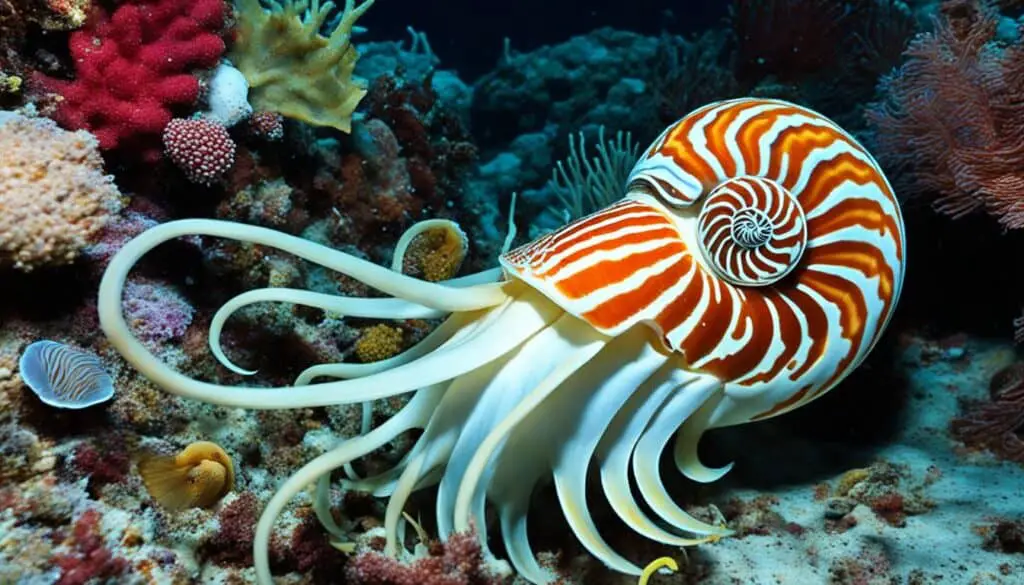
Nautilus Predatory Instincts
Nautiluses are fascinating creatures known for their unique looks and hunting skills. They have special ways to find prey and move through the water. This helps us understand how they hunt effectively.
Prey Detection through Chemosensory Organs
The nautilus has special organs that help it find food. These organs can pick up chemical signals from other animals in the water. This lets the nautilus find food easily in the deep sea.
Vertical Migration for Improved Foraging
Nautiluses move up and down in the water, a behavior called vertical migration. They go up at night to find more food. This move helps them hunt better in the dark.
Nautilus Foraging Techniques
Nautiluses have amazing ways to catch their food. They use their tentacles to wrap around prey, making sure they don’t get away. This helps them eat things like shrimp and small crabs more easily.
Wrapping Tentacles for Capture
When they find food, nautiluses use their tentacles to grab it. This way, they can pull the food towards their beak. It shows how well they are adapted to catch food in the ocean.
Adjusting Buoyancy for Effective Hunting
Nautiluses can change how buoyant they are with their shells. This lets them move around in the water to find the best spot to hunt. They can see better and get closer to their food this way. This skill is key to their survival in the ocean.
FAQ
How do nautiluses hunt for food?
Nautiluses hunt by actively searching for prey and scavenging for food. They look for things like crustaceans and dead animals. They also use what’s available in their environment.
What are the main components of a nautilus’s anatomy that aid in hunting?
Nautiluses have about ninety tentacles with grooves for catching prey. They also have a siphon that helps them move and stay buoyant. These features are key to their hunting.
What do nautiluses primarily eat?
Nautiluses eat mainly meat, including shrimp, crabs, and small sea creatures. They eat what they can find, making them adaptable in different places.
How do nautiluses detect their prey?
Nautiluses use their sense of smell to find food. They don’t rely much on their eyes because they are not very developed. This helps them find food in the deep sea.
Do nautiluses exhibit any particular hunting behavior during different times of the day?
Yes, nautiluses move from deep to shallow water at night to hunt. This helps them hunt better in the dark. It’s a smart way to find food.
What techniques do nautiluses use to capture their prey?
Nautiluses catch prey by wrapping their tentacles around it. They then pull it towards their sharp jaw. They also adjust their buoyancy to get into good hunting spots.

